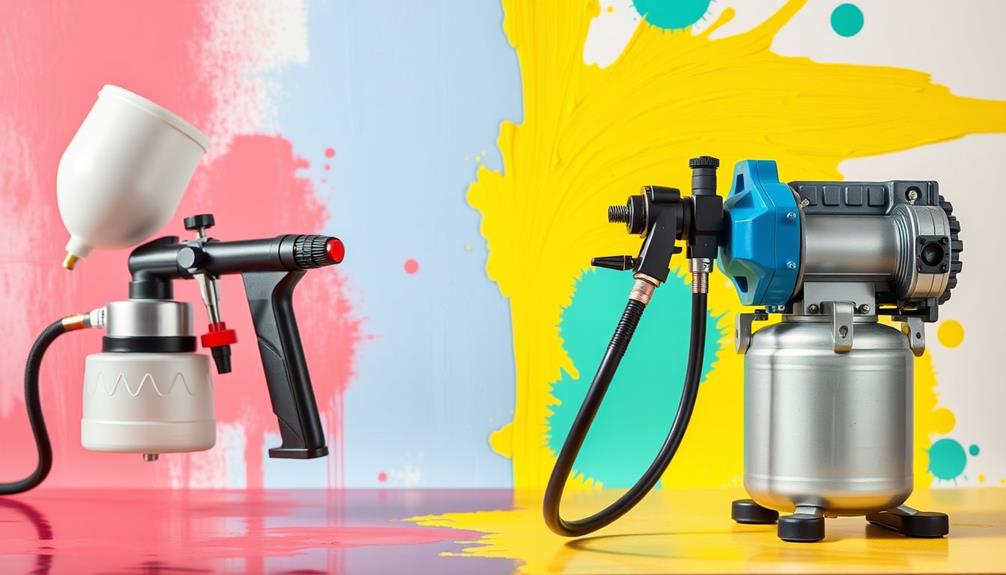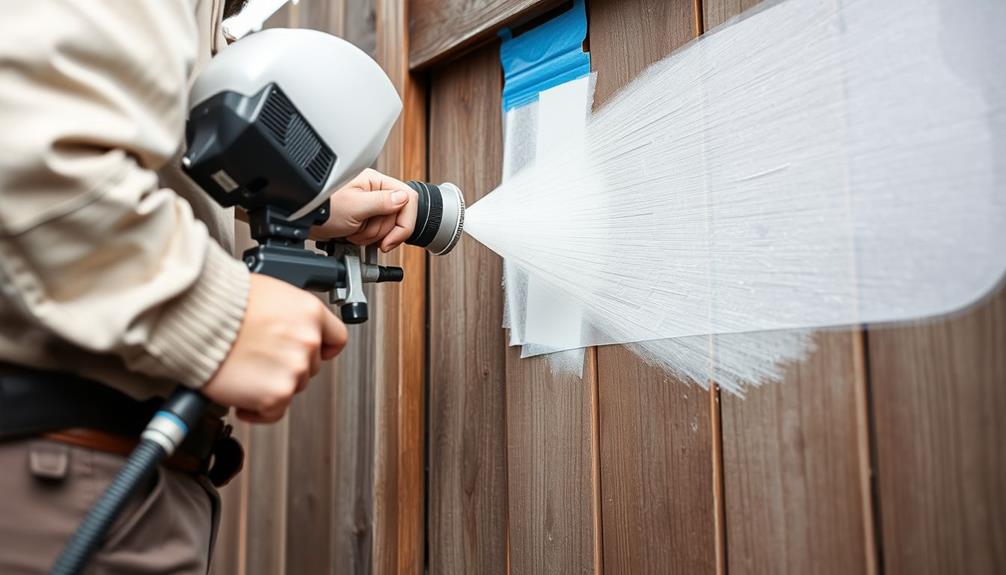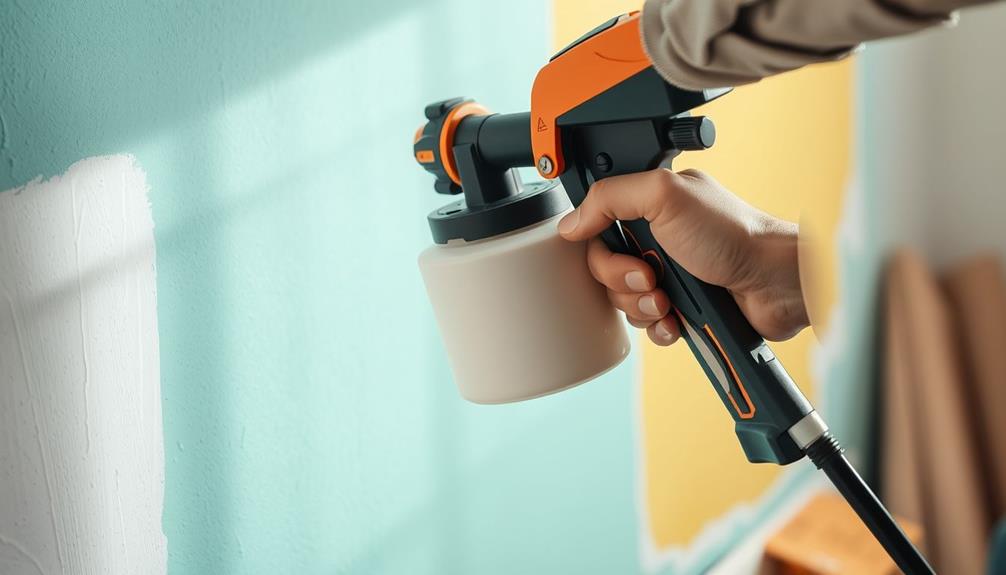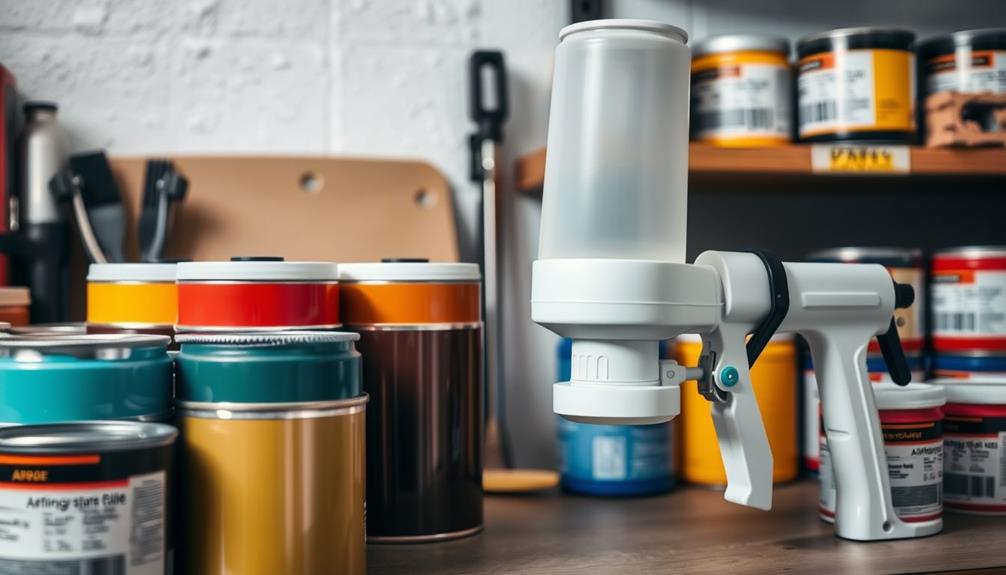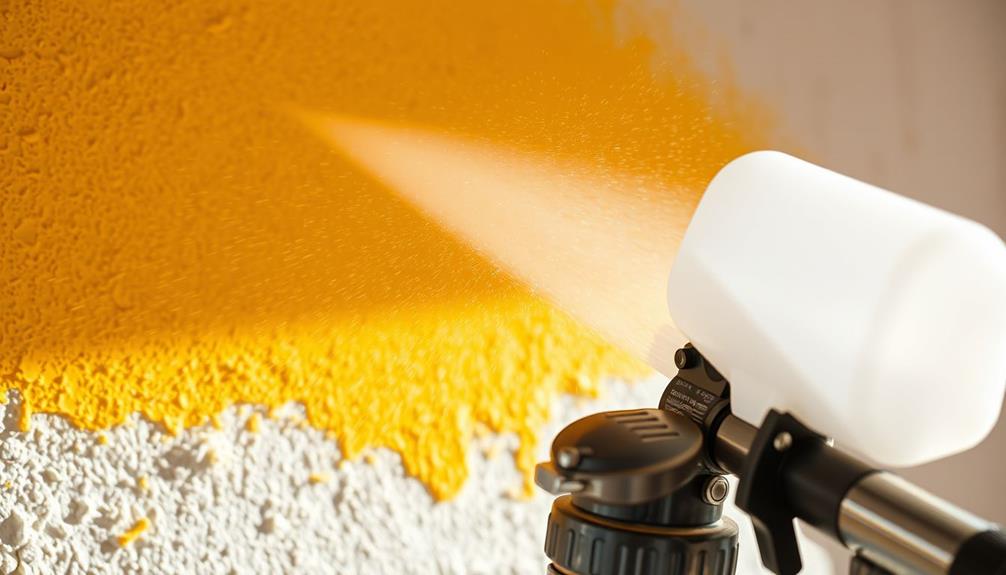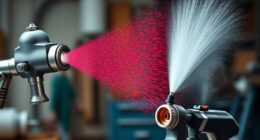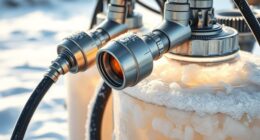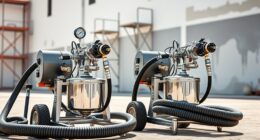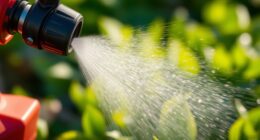When deciding between an airless paint sprayer and a compressed air sprayer, it really depends on your project needs. If you're tackling large surfaces quickly, an airless sprayer is your best bet, as it delivers fast, uniform coverage while handling thicker paints effectively. On the other hand, if you're focusing on detailed work, like trim or small furniture pieces, a compressed air sprayer excels at providing a fine finish with minimal overspray. Both options can yield professional results, but understanding their strengths will help you choose the right one for your project. There's more insight to uncover about each option.
Key Takeaways
- Airless sprayers are ideal for large surfaces, providing quick and uniform coverage, while compressed air sprayers excel in detailed work and intricate designs.
- Choose airless sprayers for thick materials that can be applied directly, whereas compressed air sprayers are better suited for thinner paints.
- Airless systems reduce paint wastage and save time, making them cost-effective for extensive projects compared to the slower compressed air sprayers.
- Consider the desired finish quality: compressed air sprayers offer finer finishes, while airless sprayers may provide a less refined outcome on large surfaces.
- Evaluate project size and detail level to determine the best sprayer; airless for speed and coverage, compressed air for precision and detail.
Overview of Spray Painting Techniques
When it comes to spray painting techniques, you've got two primary options: air spray and airless spray systems.
Air spray utilizes compressed air to atomize paint into fine droplets, making it perfect for detailed work and achieving a smooth, consistent finish on smaller projects. However, it tends to produce more overspray compared to airless systems, which can lead to paint wastage.
Airless paint sprayers are particularly advantageous for large surfaces, offering faster application and high transfer efficiency, making them ideal for extensive painting projects.
On the other hand, airless sprayers operate without compressed air, using high-pressure pumps to atomize paint. This method allows you to cover large areas quickly and efficiently, making it ideal for extensive surfaces.
Airless systems handle a variety of types of paint, including thicker materials, with higher transfer efficiency. Because they produce less overspray, you can save time and materials during your projects.
Ultimately, your choice between air and airless spray techniques will depend on your specific needs. If you're focusing on intricate details, go with air spray.
But if speed and coverage for large areas are your priorities, airless sprayers are the way to go. Each method has its advantages, and understanding them can help you achieve the best results for your project.
Key Differences Between Sprayer Types
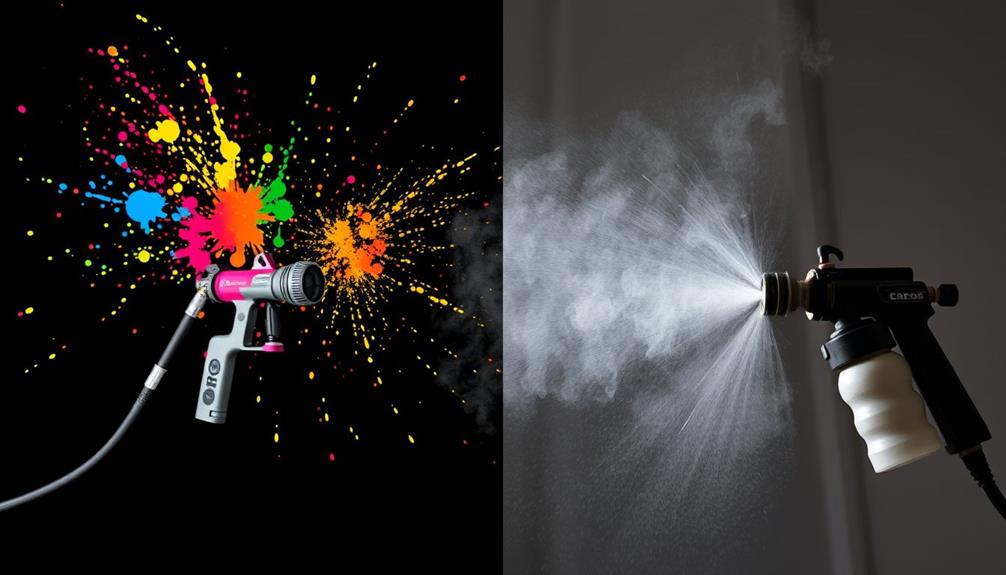
Understanding the key differences between airless and compressed air sprayers can greatly impact your painting projects. Airless sprayers use high pressure to atomize paint, making them perfect for covering large areas quickly. In contrast, compressed air sprayers operate using compressed air to create a fine mist, which is ideal for detailed work.
Additionally, using a Graco FFLP Fine Finish Low Pressure Reversible Tip can enhance the performance of airless sprayers for intricate projects.
When it comes to transfer efficiency, airless sprayers generally outperform their HVLP counterparts, reducing overspray and waste considerably. This means you'll get more paint on your surface rather than in the air.
Furthermore, airless sprayers can handle thicker materials, like latex paints, straight from the can, while compressed air sprayers excel with thinner paints, such as automotive finishes.
Another key difference is the setup. Compressed air sprayers typically need a separate air compressor, which can complicate your workspace and require extra storage.
On the other hand, airless sprayers draw paint directly from a container, making them more portable and easier to use.
Ultimately, if you're focused on speed and efficiency for larger projects, airless sprayers are your best bet; for intricate applications, you might prefer the control offered by compressed air sprayers.
Finish Quality and Application Suitability
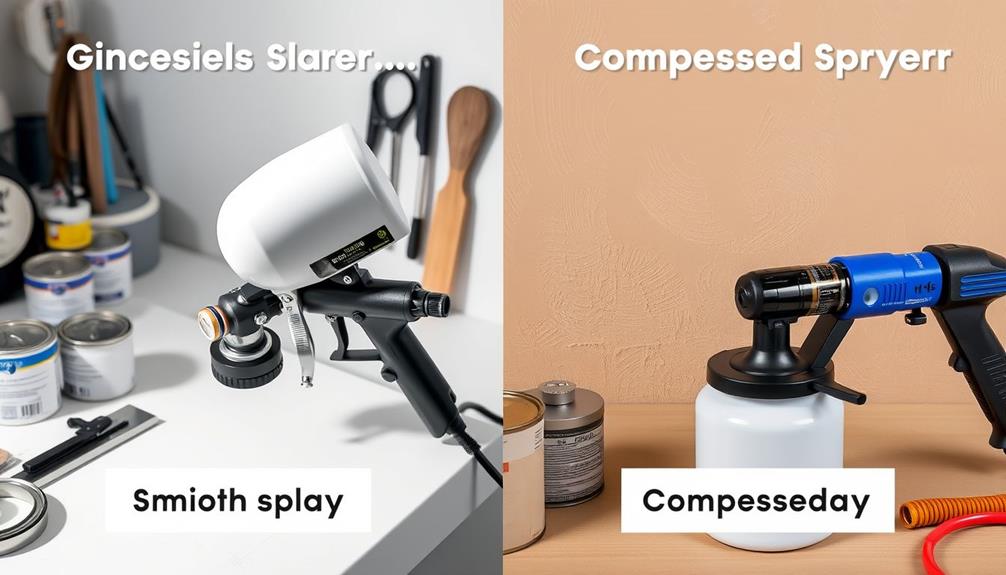
When choosing between airless and compressed air sprayers, consider the balance between detail and coverage.
Airless sprayers are great for quickly covering large surfaces, making them ideal for projects like Island Getaways where time efficiency is essential, while compressed air sprayers excel at achieving a fine finish on intricate projects.
Your choice will depend on the type of surface you're working with and the level of detail you need.
Detail Vs. Coverage
Detail and coverage are two essential factors to take into account when choosing between airless and compressed air sprayers.
If you're working on large surface areas, airless sprayers shine by providing uniform coverage quickly and efficiently, making them ideal for projects like exterior walls or commercial buildings. Additionally, employing techniques similar to those found in DIY Kitchen Wall Decor can enhance your overall painting project.
However, if your focus is on detailed work, compressed air sprayers are your best bet. They produce a fine mist that allows for superior control, resulting in smooth finishes that are perfect for trim, cabinets, and furniture.
While airless sprayers can handle thicker materials without thinning, the finish quality may not be as refined as what you get with compressed air sprayers. For intricate designs or delicate applications, you'll want the precision that air sprayers offer.
Ultimately, the choice depends on your project's scale and the finish quality you desire. If speed and coverage are your priorities, go for airless sprayers. But if you need precision and fine detail, compressed air sprayers will meet your needs better.
Balancing these factors will help you achieve the best results for your specific painting project.
Surface Type Considerations
Choosing the right sprayer for your project often hinges on the surface type and the finish quality you're aiming for.
If you're tackling a large surface, like exterior walls or commercial spaces, airless sprayers are ideal. They provide a consistent spray pattern, ensuring uniform coverage. However, keep in mind that the finish quality may not be as refined; airless sprayers can produce higher overspray, which might necessitate extra touch-ups.
Additionally, employing techniques like mindful eating practices can improve your overall well-being, allowing you to focus better on your project.
On the other hand, if your project involves intricate detail finishes—think trim work, cabinets, or furniture—compressed air sprayers are your best bet. They excel at delivering the finesse needed for these tasks, resulting in a superior finish quality compared to airless systems.
Compressed air sprayers work best with thinner materials, like automotive finishes, while airless sprayers can handle thicker materials, including latex paints.
Ultimately, the choice between airless and compressed air sprayers depends on your specific project needs. For large surfaces, go airless; for detailed work, opt for compressed air. Understanding these surface type considerations will help you achieve the best results.
Cost Efficiency and Labor Considerations
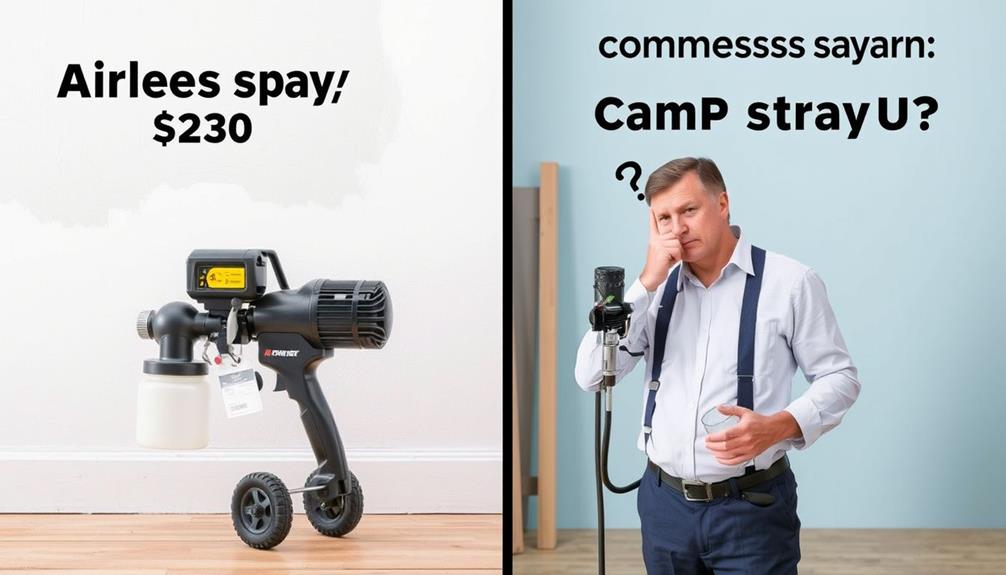
Cost efficiency and labor factors play an essential role in determining the right paint sprayer for your project. When weighing your options, you'll find that airless sprayers often lead to quicker completion times, driving down labor costs considerably. They excel in application speeds, making them ideal for larger projects, while also reducing paint wastage and minimizing the need for multiple coats.
Additionally, when selecting tools for your project, it's important to evaluate the essential items for a home cleaning kit to guarantee a thorough approach to your cleaning needs.
Examine these key benefits of airless sprayers:
- Faster application speeds save you time and money.
- Reduced paint wastage means fewer materials needed.
- Thicker paints can be used directly, cutting down on preparation.
- Higher transfer efficiency lowers overall material costs.
- Long-term savings justify the upfront investment.
Though air spray systems may seem more affordable initially, airless sprayers prove to be a smarter investment when you reflect on the long-term savings they offer. By decreasing labor costs and enhancing efficiency, you'll find that the overall value of airless sprayers shines through, especially for extensive projects.
In the end, choosing the right sprayer can't only impact your budget but also the quality of your finished work.
Usability and Setup Comparison
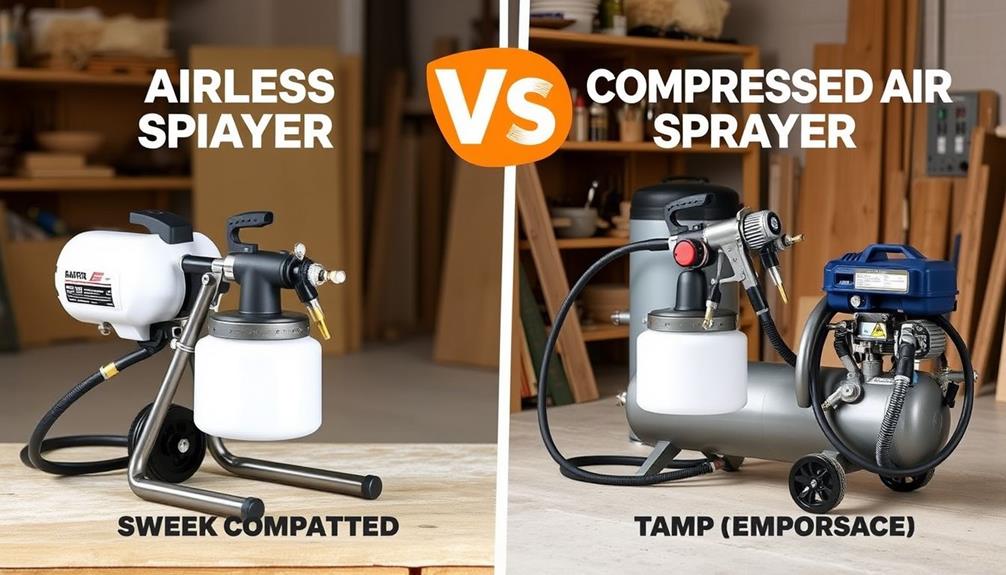
When you're tackling a painting project, the usability and setup of your sprayer can make a big difference in your overall experience. If you're working on large projects, airless sprayers are a fantastic choice. They draw paint directly from containers, allowing for continuous use without the hassle of an external air compressor. This makes the setup process quick and easy, enhancing efficiency as you engage in your work.
Additionally, just as cats show signs of emotional attachment to their owners, the convenience of airless sprayers can create a more enjoyable connection to your painting tasks emotional attachment in cats.
On the other hand, compressed air sprayers require a compatible air compressor, which can complicate the setup and take up extra space. You might find yourself spending more time organizing your workspace before you even start painting.
Additionally, airless sprayers typically have larger paint reservoirs, meaning you can work longer without frequent refills, making them more user-friendly for extensive tasks.
Cleaning is another factor to weigh. Airless sprayers are usually easier to clean due to their straightforward design, while compressed air sprayers involve more components that need careful maintenance.
Recommended Applications for Each Sprayer
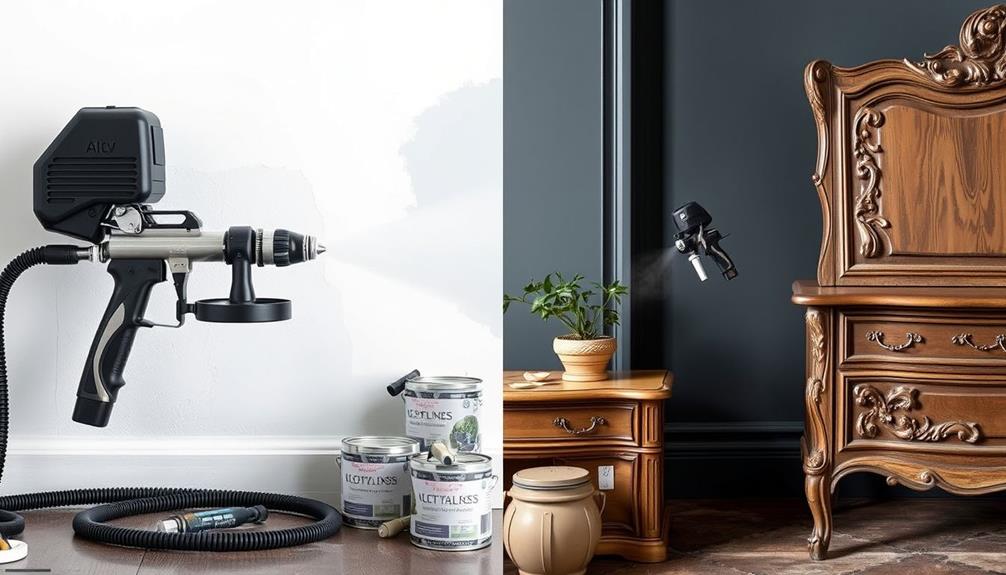
Understanding the recommended applications for each type of sprayer can help you make the right choice for your painting projects.
If you're tackling large projects, airless sprayers are your best bet. They deliver quick, uniform coverage, making them ideal for exterior walls and commercial buildings. Additionally, choosing the right tools for your project, much like selecting tough dog names, can enhance the overall outcome.
Conversely, if you need intricate detailing, compressed air sprayers, particularly HVLP sprayers, excel in providing finesse and smooth finishes.
Consider these factors when choosing your sprayer:
- Large projects: Airless sprayers handle extensive surface areas efficiently.
- Intricate detailing: HVLP sprayers are perfect for trim work and fine furniture.
- Less overspray: HVLP systems minimize waste and mess during application.
- Professional results: Both sprayers can achieve high-quality finishes, but in different contexts.
- Paint viscosity versatility: Airless sprayers use unthinned paint directly from the can.
Ultimately, your choice depends on the scope of your project. For speed and efficiency, go for airless sprayers. For precision and control, opt for HVLP sprayers. Understanding these applications guarantees you'll get the best results tailored to your needs.
Frequently Asked Questions
Which Is Better, Air or Airless Paint Sprayer?
When choosing between air and airless paint sprayers, consider your project's scale and finish quality. If you need speed and efficiency for large areas, go airless; for detail and precision, choose air sprayers.
What Is the Main Advantage to Using an Airless Sprayer Over a Compressed Air Sprayer for a Painting Project?
Did you know airless sprayers can deliver paint up to 10 times faster than compressed air sprayers? This speed lets you cover large areas quickly, giving you a more efficient and uniform finish for your project.
What Are the Disadvantages of an Airless Paint Sprayer?
Airless paint sprayers can lead to higher overspray, making paint wastage a concern. They're tougher to control for detailed work and require more paint to prime, which could frustrate you on smaller projects.
Do Airless Sprayers Give a Better Finish?
Imagine a canvas splashed with vibrant colors; airless sprayers deliver solid coverage but might not achieve that fine, silky finish you desire. For intricate details, you might find compressed air sprayers more satisfying.
Conclusion
So, there you have it! If you're after a flawless finish with minimal fuss, you might think the airless sprayer is your best bet. But who doesn't love the joys of wrestling with a compressed air sprayer, right? Just when you thought you'd made the easier choice, you find yourself in a battle of setups and costs. Ultimately, it's all about what you want for your project—ease or a true workout for your painting skills!
